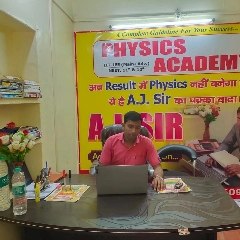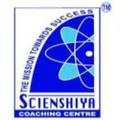Question 1 :
The division of energy by time is {tex} \mathrm { X } . {/tex} The dimensional formula of {tex} \mathrm { X } {/tex} is same as that of
Question 2 :
Which one of the following represents the correct dimensions of the coefficient of viscosity?
Question 3 :
The heat generated in a circuit is given by {tex} Q = I ^ { 2 }Rt {/tex} , where {tex} \mathrm I {/tex} is current, {tex} R {/tex} is resistance and {tex} \mathrm t {/tex} is time. If the percentage errors in measuring {tex}I, R {/tex} and t are {tex} 2 \% , 1 \% {/tex} and {tex} 1 \% {/tex} respectively, then the maximum error in measuring heat will be
Question 6 :
{tex} \left[ \mathrm { MLT } ^ { - 1 } \right] + \left[ \mathrm { MLT } ^ { - 1 } \right] = \ldots \ldots \ldots \ldots {/tex}
Question 7 :
What are the dimensions of {tex} \mathrm { A } / \mathrm { B } {/tex} in the relation {tex} \mathrm { F } = \mathrm { A } \sqrt { \mathrm { x } } + \mathrm { Bt } ^ { 2 } , {/tex} where {tex}\mathrm F {/tex} is the force, {tex} x {/tex} is the distance and {tex} t {/tex} is time?
Question 9 :
In a simple pendulum experiment, the maximum percentage error in the measurement of length is {tex} 2 \% {/tex} and that in the observation of the time- period is {tex} 3 \% . {/tex} Then the maximum percentage error in determination of the acceleration due to gravity g is
Question 10 :
If {tex} x = a t + b t ^ { 2 } , {/tex} where {tex} x {/tex} is the distance travelled by the body in kilometers while {tex} t {/tex} is the time in seconds, then the unit of {tex} b {/tex} is
Question 13 :
Which of the following physical quantities has neither dimensions nor unit?
Question 16 :
The thrust developed by a rocket-motor is given by {tex} \mathrm { F } = \mathrm { mv } + \mathrm { A } \left( \mathrm { P } _ { 1 } - \mathrm { P } _ { 2 } \right) {/tex} where {tex} \mathrm { m } {/tex} is the mass of the gas ejected per unit time, {tex}\mathrm v{/tex} is velocity of the gas, {tex} \mathrm { A } {/tex} is area of cross-section of the nozzle, {tex} \mathrm { P } _ { 1 } {/tex} and {tex} \mathrm { P } _ { 2 } {/tex} are the pressures of the exhaust gas and surrounding atmosphere. The formula is dimensionally
Question 17 :
The resistance {tex} R {/tex} of a wire is given by the relation {tex} R = \frac { \rho \ell } { \pi r ^ { 2 } } . {/tex} Percentage error in the measurement of {tex} \rho , \ell {/tex} and {tex} r {/tex} is {tex} 1 \% , 2 \% {/tex} and {tex} 3 \% {/tex} respectively. Then the percentage error in the measurement of {tex} R {/tex} is
Question 19 :
{tex} \mathrm { E } , \mathrm { m } , \mathrm { J } {/tex} and {tex} \mathrm { G } {/tex} denote energy, mass, angular momentum and gravitational constant respectively, then the unit of {tex} \frac { \mathrm { E } \mathrm { J } ^ { 2 } } { \mathrm { m } ^ { 5 } \mathrm { G } ^ { 2 } } {/tex} is
Question 21 :
The dimensions of {tex} \frac { 1 } { \epsilon _ { \mathrm { o } } } \frac { \mathrm { e } ^ { 2 } } { \mathrm { hc } } {/tex} are
Question 23 :
Which of the following statements is/are correct?<br>I. 345.726 has six significant figures. <br>II. 0.004289 has seven singificant figures.<br> III. 125000 has three significant figures. <br>IV. 9.0042 has five significant figures.<br>
Question 25 :
In a vernier callipers, ten smallest divisions of the vernier scale are equal to nine smallest division on the main scale. If the smallest division on the main scale is half millimeter, then the vernier constant is
Question 26 :
If {tex} x {/tex} and {tex} R {/tex} stands for distance. Then which of the following is dimensionally same as {tex} \int \frac { \operatorname { Rd } x } { x ^ { 2 } } ? {/tex}
Question 28 :
Which one of the following is not measured in units of energy?
Question 30 :
If electronic charge {tex} \mathrm { e} {/tex}, electron mass {tex} \mathrm { m } , {/tex} speed of light in vacuum {tex} \mathrm { c } {/tex} and Planck's constant {tex} \mathrm { h } {/tex} are taken as fundamental quantities, the permeability of vacuum {tex} \mu _ { 0 } {/tex} can be expressed in units of
Question 32 :
A physical quantity {tex} Q {/tex} is related to four observables {tex} x , y , z {/tex} and {tex} t {/tex} by the relation {tex} Q = {/tex}{tex} \frac { x ^ { 2 / 5 } z ^ { 3 } } { y \sqrt { t } } . {/tex} The percentage errors of measurement in {tex} x , y , z {/tex} and {tex} t {/tex} are {tex} 2.5 \% , 2 \% , 0.5 \% {/tex} and {tex} 1 \% {/tex} respectively. The percentage error in {tex} Q {/tex} will be<br>
Question 33 :
{tex} \begin{array} { l l } { \text { Column I } } & { \text { Column II } } \\ { \text { (A) Length } } & { \text { (1) burette } } \\ { \text { (B) Volume } } & { \text { (2) Vernier callipers } } \\ { \text { (C) Diameter of a thin wire } } & { \text { (3) screw gauge } } \\ { \text { (D) Mass } } & { \text { (4) common balance } } \end{array} {/tex}
Question 34 :
When a small sphere moves at low speed through a fluid, the viscous force {tex} F {/tex}, opposing the motion is experimentally found to depend upon the radius {tex} r , {/tex} the velocity {tex} v {/tex} of the sphere and the viscosity {tex} \eta {/tex} of the fluid. Expression for force is
Question 35 :
{tex} \mathrm { E } , \mathrm { m } , \mathrm { J } {/tex} and {tex}\mathrm G{/tex} denote energy, mass, angular momentum and gravitational constant respectively, then the unit of {tex} \frac { \mathrm { EJ } ^ { 2 } } { \mathrm { m } ^ { 5 } \mathrm { G } ^ { 2 } } {/tex} is
Question 36 :
Mass of a body is {tex} 210 \mathrm { gm } {/tex} and its density is {tex} 7.981 \mathrm { g } / \mathrm { cm } ^ { 3 } {/tex} what will be its volume, with regard to significant digits?
Question 37 :
The current voltage relation of a diode is given by {tex} \mathrm { I } = \left( \mathrm { e } ^ { \text {1000V } / T } - 1 \right) \mathrm { mA } , {/tex} where the applied voltage {tex} \mathrm { V } {/tex} is in volts and the temperature {tex} \mathrm T {/tex} is in degree kelvin. If a student makes an error measuring {tex} \pm 0.01 \mathrm { V } {/tex} while measuring the current of {tex} 5 \mathrm { mA } {/tex} at {tex} 300 \mathrm { K } , {/tex} what will be the error in the value of current in {tex} \mathrm { mA } ? {/tex}
Question 38 :
The displacement of a body at a particular second {tex} \mathrm { n } {/tex} is given by the expression {tex} \mathrm { S } _ { \mathrm { nth } } = \mathrm { u } + \frac { \mathrm { a } } { 2 } ( 2 \mathrm { n } - 1 ) . {/tex} The dimensional formula of {tex} \mathrm { S } _ { \mathrm { nth } } {/tex} in this equation is
Question 39 :
Match the Column I and Column II.<br> {tex} \begin{array} {| l| l| }\hline{ \text { Column I } } & { \text { Column II } } \\ \hline{ \text { (A) J C Maxwell } } & { \text { (1) Verified experimentally the prediction of electromagnetic force } } \\ \hline { \text { (B) Cario Rubia } } & { \text { (2) Unified electricity, magnetism and optics, showed that light is an EM waves} } \\ \hline { \text { (C) Isaac Newton } }& { \text { (3) Unified celestial and terrestrial mechanics} } \\ \hline{ \text { (D) Michael Faraday } } & { \text { (4) Showed that electric and magnetic phenomenon i.e., electromagnetism } }\\ \hline \end{array} {/tex}
Question 40 :
Error in the measurement of radius of a sphere is {tex} 1 \% . {/tex} Then error in the measurement of volume is































